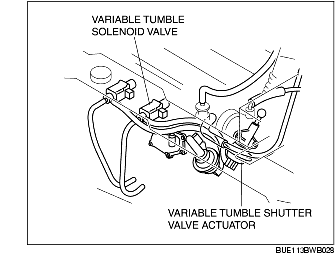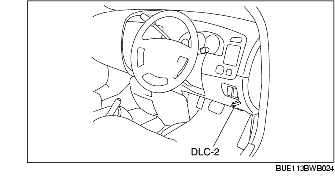VARIABLE TUMBLE SOLENOID VALVE INSPECTION [L3 R.H.D.]
id0113a2802900
Variable Tumble Control Inspection
1. Connect the WDS or equivalent to the DLC-2.
2. Using a PID/data monitor function, monitor the following PCM input signal.
-
• RPM, ECT
3. When the engine speed signal 3,500 rpm or less and engine coolant temperature less than 60 ×C {140 ×F} (only for 2WD), verify that the variable tumble shutter valve actuator rod is pulled.

-
• If it does not operate, inspect the following:
-
(1) Rod not operating under any condition
-
1) Turn the ignition switch to the ON position.
-
2) Using a simulation function "IMRC", verify the variable tumble solenoid valve operating sound.
-
• If the operation sound can be confirmed, inspect for the following:
-
- Vacuum hose disconnection or damage (intake manifold- variable tumble solenoid valve- variable tumble shutter valve actuator)
-
- Variable tumble shutter valve actuator
-
• If the operation sound cannot be verified, inspect the following:
-
- Variable tumble solenoid valve
-
- Wiring harnesses, connectors: open circuit (main relay- variable tumble solenoid valve-PCM)
-
(2) Rod is operating under any condition
-
1) Turn the ignition switch to the ON position.
-
2) Using simulation function "IMRC", verify the variable tumble solenoid valve operation sound.
-
• If the operation sound can be confirmed, inspect for the following:
-
- Variable tumble shutter valve actuator
-
• If the operation sound cannot be verified, inspect the following:
-
- Variable tumble solenoid valve
-
- Wiring harnesses, connectors: open circuit (variable tumble solenoid valve-PCM)
-
(3) If the operation area is different
-
• PCM terminal voltage (using a PID/data monitor function)
-
- MAF
Airflow Inspection
1. Disconnect the negative battery cable.
2. Remove the variable tumble solenoid valve.
3. Inspect for the airflow between the ports under the following condition:
-
• If it is within the specification, inspect for the related wiring harnesses.
-
• If it is not within the specification, replace the variable tumble solenoid valve.
Standard
|
Measurement condition
|
Airflow
|
|
Between ports A-B
|
Between ports B-C
|
|
Apply B+ to terminal A, and connect terminal B to ground
|
Airflow detected
|
No airflow
|
|
Apply B+ to terminal A, and not connecting terminal B to ground
|
No airflow
|
Airflow detected
|
